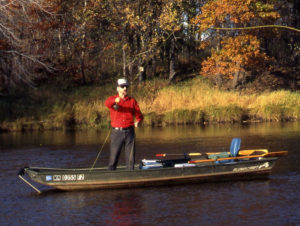
A Good Anchor System
It’s amazing how many more fish you catch if you have good craft control. To see the difference, let’s look at how a typical day of fishing goes, either with or without a well-rigged boat and good craft control. I’ve seen each of these scenarios many, many during my lifetime of river fishing and nearly thirty years as a professional angler.
Start with an 8 mile stretch of smallmouth river. In this section of river, the smallmouth locations range from “fair” to “good” and average 12 per mile. These include small bank eddies, large bank eddies, downed trees, mid-stream boulders, rocky runs, small pools, heads of pools and tails of pools. So this is a typical stream with about 100 spots worth fishing.
Now add to this scene a solo fella in a kayak, canoe, small raft or small jonboat and without any anchor, instead just using oars or paddles to control his craft. He shoves off from the landing rigged and ready to really hook those smallies. But the very first bank eddy is next to the mid-river current, which is fairly stiff, so he goes right by it before he can even pick up a rod. Then around the bend is a downed log that looks promising, but he is almost past it before he can get a cast off. The lure/fly lands a little too far from the log, so no fish is willing to leave their woody hideout to chase down the bait. Then a decent-sized pool is next, and since the current is slow the angler does get several casts off, and he manages two strikes and lands one fish. But now the current is increasing and the fella is through the pool and into a riffle.
A mid-river boulder whizzes by and looks so good the guy strains to paddle back upstream so he can make a couple casts to it. That is tiring, and then his craft quickly drifts too close to the boulder, so he makes just one cast to it. And so it goes the rest of the day. Out of the nearly 100 spots, he only fishes about 30 percent of them and often these attempts aren’t very effective, since his craft drifts too close (or too far) or goes by too quickly. He does stop and try to fish on foot below a couple of riffles, but the rocks are pretty slippery, and after a dunking he loses interest in that method. Finally after several hours of paddling or rowing and trying to fish, he ends up with 7 smallies and a couple rock bass.
The Good Control Difference
Now the next day another angler comes down that same river in a properly rigged kayak with a good stern anchor system. Or I come down the stream in my well-rigged canoe with a friend or client in the bow. At that first bank eddy, the kayaker drops his anchor and makes half a dozen good casts (or I do likewise in my canoe). The anchored canoe or kayak angler catches three nice smallies from this spot, and at the next log he gets a couple more. It goes on like this the rest of the day. Sure, he misses a few of the spots and messes up a few more by getting too close, but instead of just hitting 30 spots, he effectively fishes over 80 of them. And instead of just 7 smallies, the guy with good craft control lands 37 fish that day.
That’s over five times as many fish caught, and it is simply because the craft was in better position, mostly due to a good anchor system. While I can’t take most of you down the river in one of my well-rigged craft, everyone can rig a good anchor system into their own fishing craft.


Tim, thanks for posting some new content! I agree that boat positioning is critical to success, and is a challenge for a solo angler in a canoe or kayak. But there are also dangers to using an anchor in a canoe or kayak in swift water; even a moderate current can drag a narrow vessel in such a way as to cause it to turn over. I carry an anchor in my canoe, but rarely use it in rivers because of safety concerns.
So I’d love to hear more about how you rig your anchors to your canoe, how you deploy them, and how you chose a spot to anchor in without risking getting turned over.